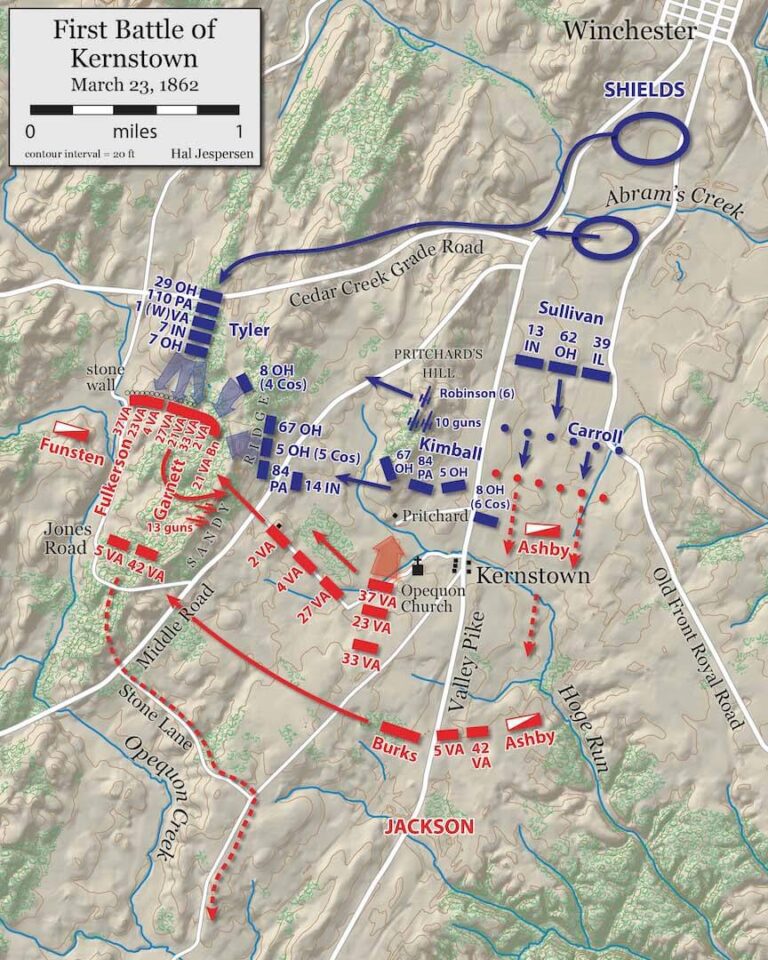The site of two significant battles, Kernstown, Virginia, is home to a 388-acre Civil War battlefield park. The site features a Kernstown battlefield Visitor Center to help bring the story of the battles to life and the Pritchard House, the 1854 home of the Pritchard family, who had to take cover as the battle raged on their land.
The site of two significant battles, Kernstown, Virginia, is home to a 388-acre Civil War battlefield park. The site features a Kernstown battlefield Visitor Center to help bring the story of the battles to life and the Pritchard House, the 1854 home of the Pritchard family, who had to take cover as the battle raged on their land.
In March 1862, the mission of the Confederacy’s Gen. Stonewall Jackson was to keep as many Union troops in the Shenandoah Valley as possible, to prevent them from driving deep into the heart of the South. Meanwhile, Gen. Joseph E. Johnston had been withdrawing his own troops from Centreville–Manassas to protect Richmond, the Confederate capital.
Jackson’s adversary in his mission was the Union’s Maj. Gen. Nathaniel P. Banks – he had to tie him down in the Shenandoah Valley. To put a stop to Banks’ attempts to leave the Valley and create an opportunity for the retaking of the town of Winchester, Jackson forced his men to perform a grueling 40-mile march in cold, inclement weather.
Due to unverified reports from local civilians, Jackson believed his 3,000 troops were heading north to meet a depleted Union Army of comparable size. However, the information was incorrect. When Jackson’s forces arrived in Kernstown, they would be launching an assault on Union forces numbering almost 9,000.
The opposing armies met at the Pritchard Farm, Kernstown, on March 23, 1862. Union forces were based in a dominant position, with their artillery lining the ridge of Pritchard’s Hill. Jackson wanted to immobilize the Union cannons as quickly as possible and ordered Col. Fulkerson and Gen. Garnett to attack the hill. But after taking heavy losses, the Confederates were forced to move west and take cover in woodland.
Here, the Confederates could fight back boldly and volley approaching Union soldiers with wave after wave of rifle fire. It was, though, to be short-lived. The Confederates quickly ran out of ammunition, and they were ultimately overwhelmed by the superior size of the Union forces.
Ordering his troops to retreat, Stonewall Jackson faced his only battlefield defeat of the American Civil War. However, what was to be a defeat on the day represented victory when looked at strategically.
Lincoln and his generals regarded Jackson’s audacious attack on much larger forces than his own to be of grave concern.
Fearing similar events, Lincoln ordered Gen. Banks to move his troops back along the Shenandoah Valley.
Jackson had been able to prevent 60,000 Union troops from joining McClellan’s campaign on Richmond. The Confederates had lost the battle, but their main objective was achieved. Some historians even say that it was Jackson’s efforts at Kernstown that would enable the rise of Gen. Robert E. Lee and ultimately continue the war for two more years.
At the Battle of Kernstown, 118 Union soldiers lost their lives, while the Confederate Army lost 80.
Today, the battlefield at Kernstown is administered by the American Battlefield Trust.
Guests to the site can look forward to visiting Pritchard Farmhouse. This 1854 farmhouse was standing during the battle, the family residing there even had to take shelter in the basement to ensure they were not harmed by stray gunfire.
Inside the home is a museum and visitor’s center that help bring the story of the First Battle of Kernstown to life. On the battlefield, you will enjoy the splendid natural surroundings of Rose Hill Park and observe the drystone wall that played a pivotal part in the battle itself.
If you have any questions or comments, please contact us.

Ready to explore the battlefield for yourself? Browse our full selection of American Civil War Battlefield Tours.
Please contact us if you have any questions about our tours or services.